Ecommerce sales jumped. General merchandise retailers, supermarkets, etc., booked solid gains. Lower prices cut gasoline & auto sales. But restaurants?
By Wolf Richter for WOLF STREET.
Retail sales for February rose only 0.2% seasonally adjusted, after the big drop in January. Year-over-year, they rose 3.1%, a smaller increase than in January (+3.9%). And they were confusing.
Sales at ecommerce retailers, general merchandise retailers (includes Walmart), food and beverage stores, and health & personal care stores all rose at a good clip month-to-month and year-over-year. This would indicate that there is not a general U-turn in consumer spending on goods.
Sales at gas stations fell because the price of gasoline fell month-to-month and year-over-year, not because people suddenly bought fewer gallons of gasoline. And sales at auto dealers fell amid lower new-vehicle prices, which reduced dollars-sales. But new-vehicle unit sales in February, seasonally adjusted, rose from January and were up year-over-year. So that’s not a sign of weakness either.
But sales at restaurants fell sharply, even though prices continued to increase at a good clip, and we’re going to keep our eyes on this one.
Ecommerce sales bounced after the drop in January. Sales at nonstore retailers (mostly ecommerce but also stalls and markets) jumped by 2.4% in February from January, seasonally adjusted, and were up 6.5% year-over-year, which indicates that consumers are not cutting back. Ecommerce is the second largest retailer category, after auto dealers.
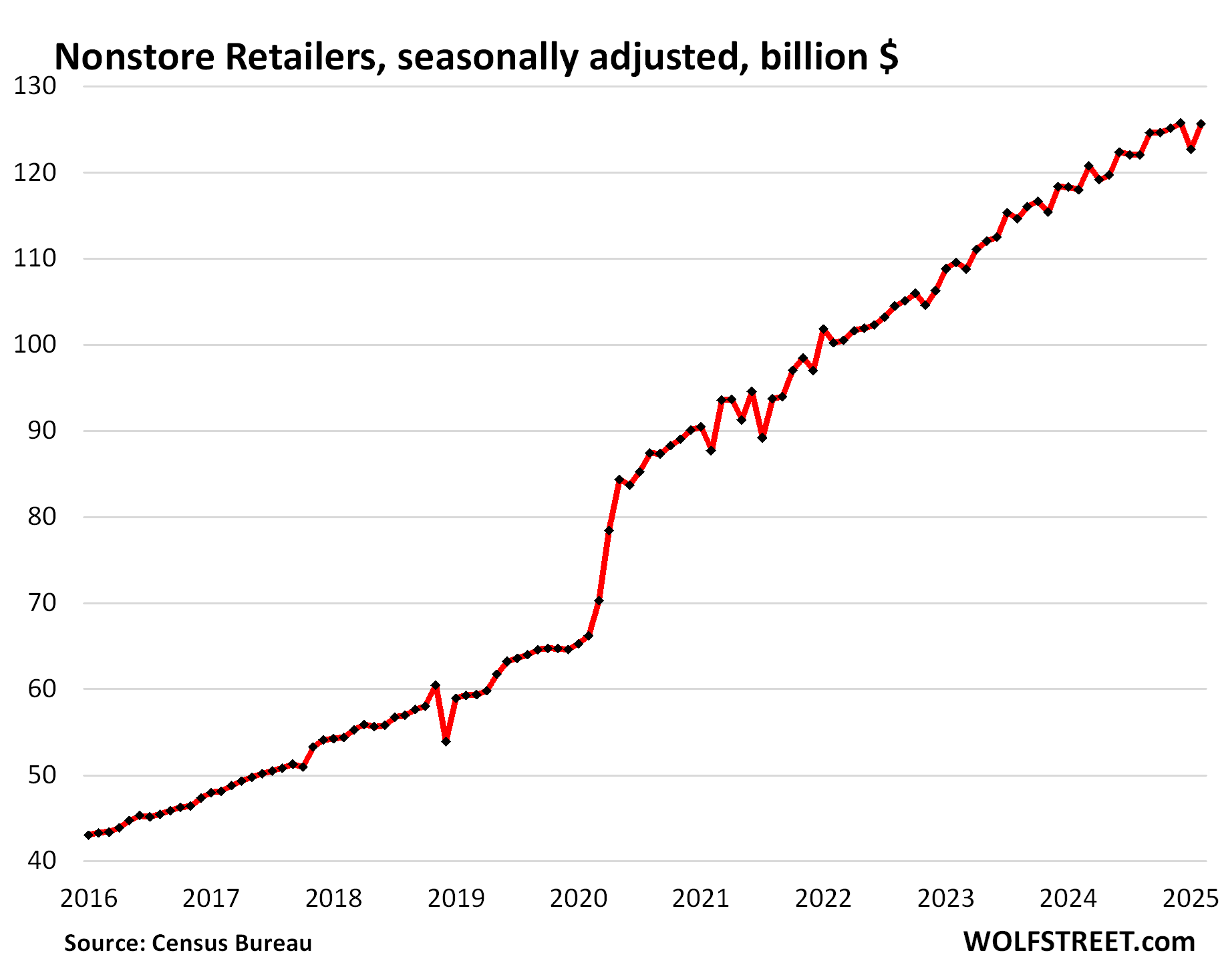
Sales at general merchandise retailers rose by 0.5% month-to-month and by 4.6% year-over-year, seasonally adjusted, to a new record.
This is the fourth-largest category behind auto dealers, ecommerce, and restaurants. These retailers sell everything from patio furniture to food – Walmart is in this category. But department stores are tracked separately, and we exclude them from this measure.
That sales at these retailers didn’t even experience a slowdown in January and then grew further in February also indicates consumers are not necessarily cutting back.
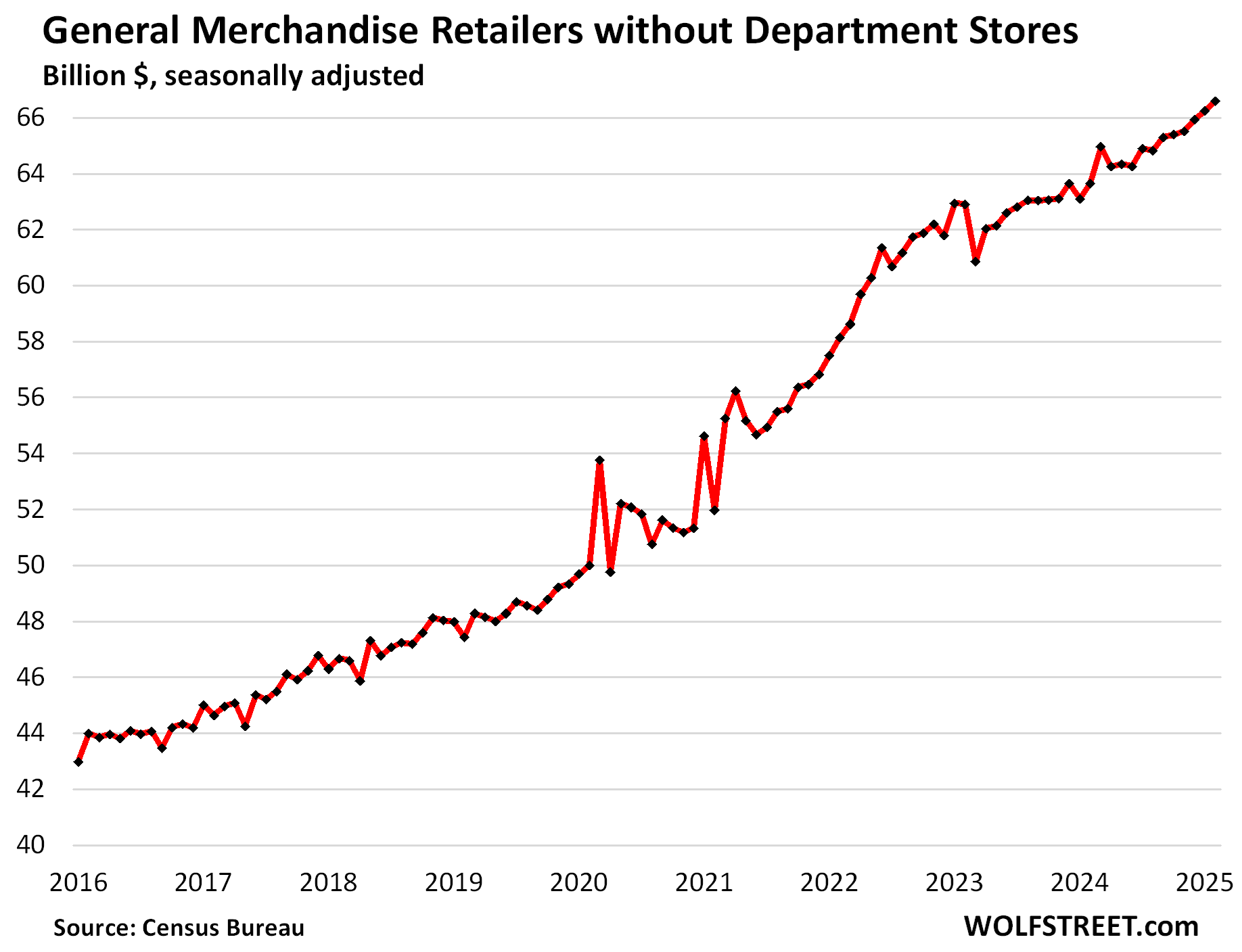
Sales at food and beverage stores rose by 0.4% for the month and by 3.9% year-over-year, seasonally adjusted, about double the rate of food inflation.
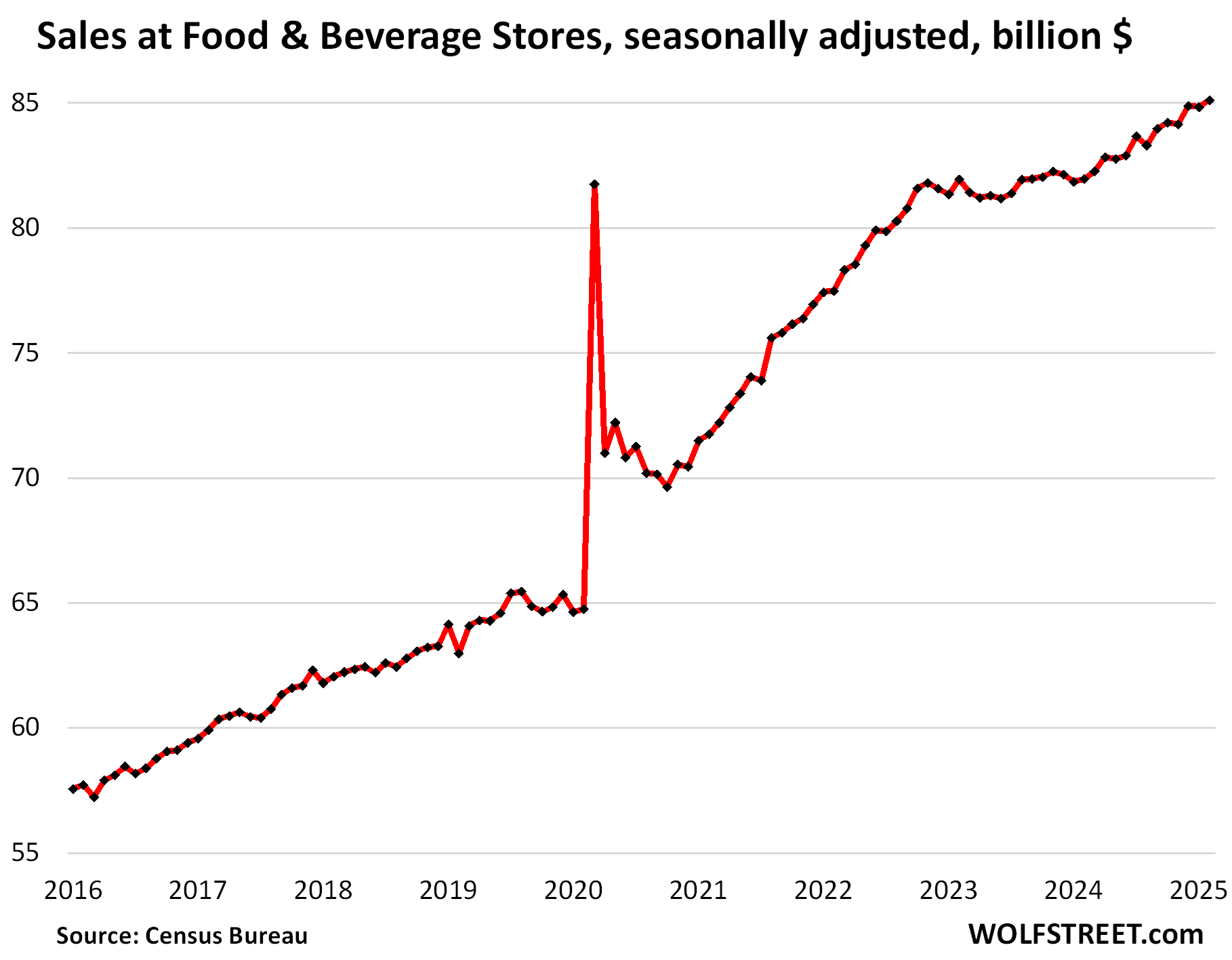
Sales at health & personal care stores jumped by 1.7% in February from January and by 6.7% year-over-year.
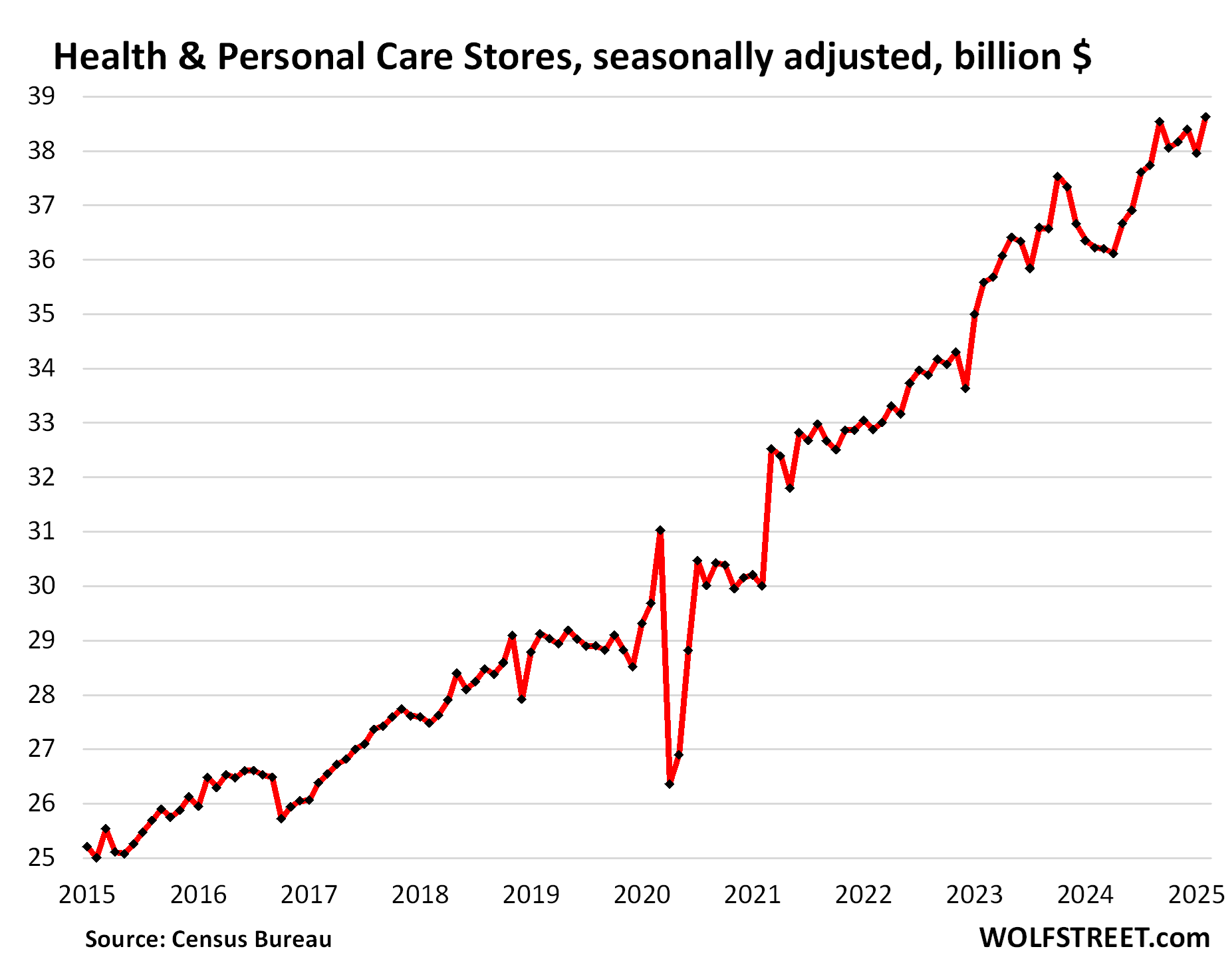
Where sales were weak, amid falling prices of what they sell.
Sales at gas stations fell 1.0% month-to-month and were down a hair from a year ago. But they didn’t fall because people bought fewer gallons of gasoline; they fell because the price of gasoline fell.
Gasoline prices fell in February month-to-month and were down year-over-year [the CPI for gasoline is discussed in my series, Beneath the Skin of CPI Inflation], and gasoline retail sales, measured in dollars, track gasoline prices closely. The chart shows how sales at gas stations rise and fall with gasoline prices:
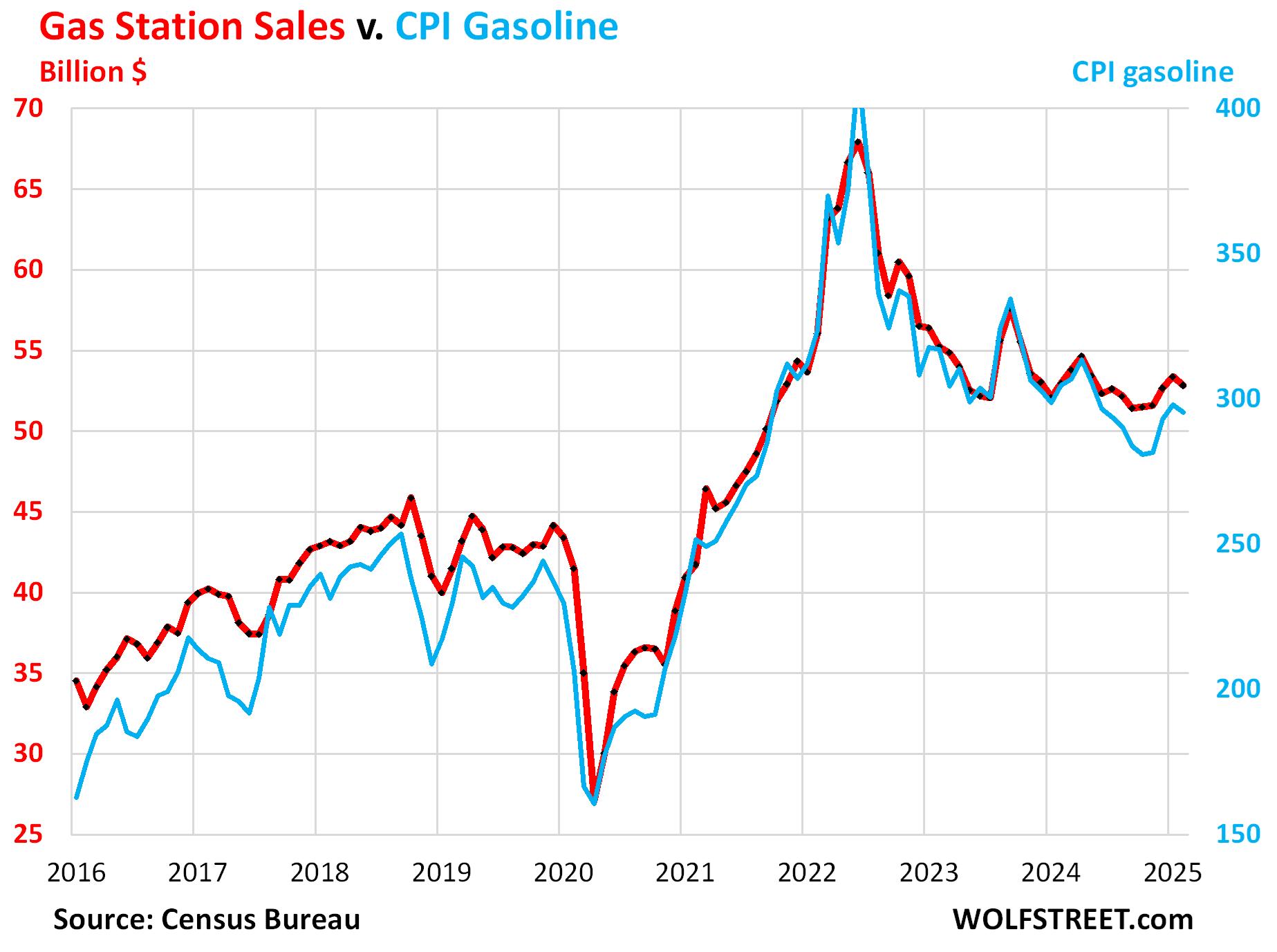
Sales at auto & parts dealers fell for the second month in a row, this time 0.4% month-to-month, seasonally adjusted, in dollar terms. But they were still up 3.1% year-over-year.
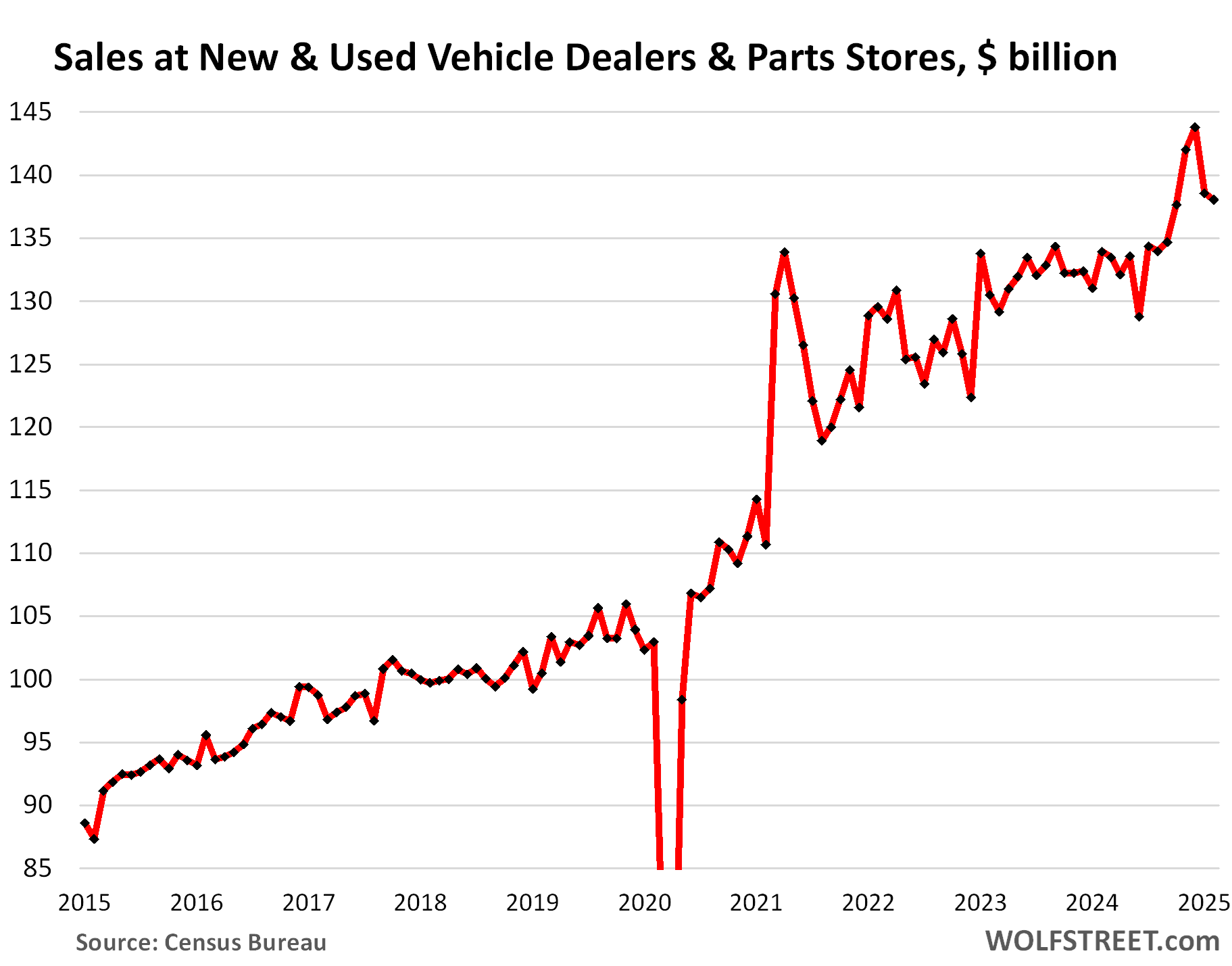
But new-vehicle unit sales rose 3.2% for the month and 2.1% year-over-year, seasonally adjusted.
This chart of the seasonally adjusted annual rate of unit sales, released by the BEA, shows the jump in sales late last year. February sales were at the top of the range for the years since the pandemic.
There has been no growth in new-vehicle unit sales in four decades, and we discussed this mess here with some ugly charts of annual unit sales by automaker. The only growth in dollar-sales is through higher prices and fancier models, but that has now stalled after the spike during the pandemic.
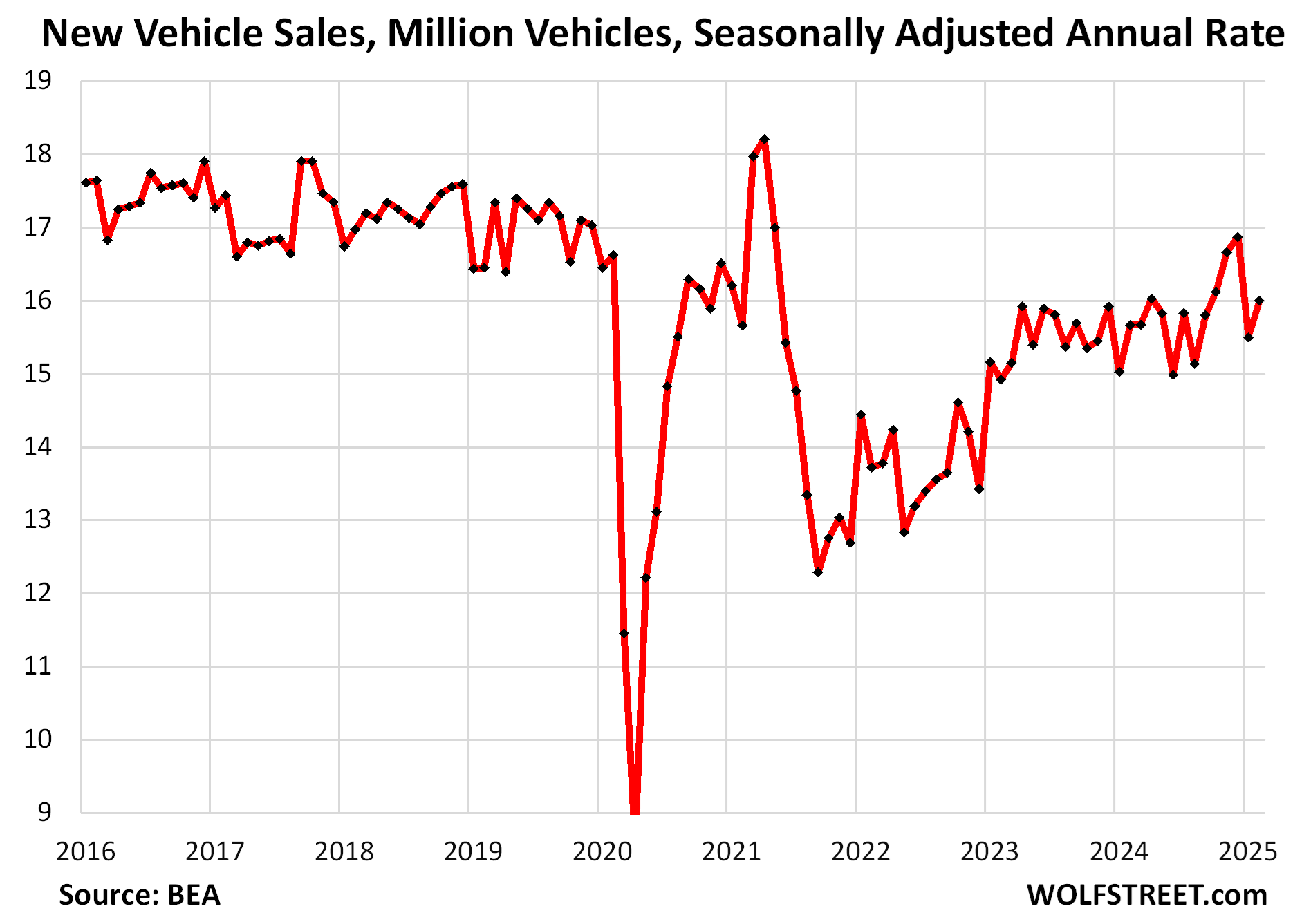
And then there is this kink.
Sales at food services and drinking places fell by 1.5% in February from January, which reduced the year-over-year gain to just 1.5%, seasonally adjusted. The past three months – December through February – have been weak.
This is something we’re going to keep our eyes on because the CPI for food away from home, which tracks inflation in restaurants and other eateries, has continued to rise at a substantial clip (+0.4% month-to-month and +3.7% year-over-year in February). Through November, sales in this sector had been growing strongly. But now there’s this decline. If this turns into a trend with another lousy reading in March, it’s something to be fretting over:

Which is why retail sales for February were so confusing. Some parts with a very broad selection or merchandise, including ecommerce and general merchandise stores, had strong sales growth. Other segments were weak due to lower prices in these segments – gasoline and autos – and that would be a sign not of consumer weakness but of lower prices. But restaurant sales were weak despite higher prices. And if that sticks, it would be a disconcerting kink that might indicate that our Drunken Sailors are sobering up.
Enjoy reading WOLF STREET and want to support it? You can donate. I appreciate it immensely. Click on the mug to find out how:
![]()

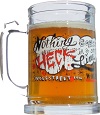
The drunken Sailors are still spending like there is no tomorrow. I couldn’t even get a reservation for St Patricks day at my local Irish Pub. I had to spend the day doing landscaping work in my back yard instead.
Sell your second car, buy triple-short ETF. Thank me later.
We just bounced off the second seasonal inflection point. The time to sell short will be May 4th.
You’re not seeing forest for the trees.
It’s the safest time. The rate-of-change in monetary flows, the volume and transaction’s velocity of our means-of-payment money, the proxy for the real output of goods and services, is decelerating, but is not yet in negative territory.
Commercial bank credit, all banks, is up, so then are loans/investments = deposits.
The FOMC’s proviso “bank credit proxy” used to be included in the FOMC’s directive during the period Sept 66 – Sept 69.
You’re not wrong. I also had May 1st in some of my notes. This sell-off so far follows ’21/’22. Small caps chart is like carbon copy. Same double-top 2-months top formation in sp500 and Nasdaq.
Im waiting for a bounce to reload, but it may never come. Keeping core position; will trade around it.
Our second car is a 2006 Ford Expedition. We wouldn’t get much.
Looking at the dining category specifically, I don’t think there’s another category that you referenced that gets even close to having such a high percentage of labor costs as a percentage of total expenses.
Dining out tends to be pretty discretionary, and with hourly rates increasing substantially in urban areas in particular, it seems to me that going to restaurants has gotten painfully expensive.
Personally, I’m not at all surprised at this category has declined, but I guess I’m also a little bit surprised at the other ones haven’t as well…
I dine out all the time – on my back patio. Macaconi and Cheese, and hamburger helper. I’m livin’ the life. “Waiter!”
I just had a $7 frozen pizza.
Organic frozen pizza.
I don’t eat a lot and dining out is often cheaper than groceries in my not-so-high-end area. A take-out meal lasts me 1-2 days ($15-20) and is so high calorie that I’m not hungry. I cannot match that with groceries, where I average $60-70 for three days.
BAG,
No offense, but maybe you need to figure out a better way to shop (or you’re just fooling yourself).
I eat incredibly well, mostly at home, and for a small fraction of what eating out looks like. Granted, my wife is an amazing worldwide cook, and super smart about shopping, not wasting, etc.
Honestly, in the States, we’re almost always disgusted how we (often either of us) could have made it better. And, in general, quality keeps going down all over the place.
JDB. To add some perspective to your comment, I operate as a fractional CFO to a wide range of businesses including two restaurants operating in CA. The reason I mention CA as this is ground zero for high labor costs. The two restaurants are good sized ($10 million plus a year in annual sales), operate in the casual/full service space, and do generate a reasonable profit. Here are some target ratios the restaurants strive to hit on a consistent basis:
– Core gross margin/profit (i.e., total sales less direct food and beverage costs) of roughly 72 to 73% (so direct costs of 27 to 28%). Would love to hit 75% but with food prices in particular being volatile and constantly increasing, its hard to play “catch-up”.
– Total fully loaded wages (i.e., base pay plus all forms of direct burden including payroll taxes, health insurance, etc.) of roughly 40% of top line sales (with a target of 38%). Again, would love to hit the lower figure but managing businesses which tend to have high personnel turnover rates in a state such as CA makes it challenging.
– In the real world, this leaves roughly 32% of total sales to cover controllable and non-controllable expenses (e.g., rent, utilities, marketing, supplies, etc.). Ideally, the restaurants should be at 35%+ but given the market conditions present, especially with food and labor costs, its difficult.
To your point, in this real life example (which I know is a very limited sample size), 40% of the top line sales is consumed by fully burdened labor costs. BTW, if you’re not paying attention and managing this cost every day, it will absolutely destroy your restaurant business.
One other data point I’ll pass along is that these two restaurants have seen flat to slightly decreasing customer counts for the past three years as it is a battle everyday to place the customer in your restaurant’s seat. This is a problem for the entire industry as multiple operations/concepts have seen lower customer counts resulting in closed units or entire restaurant companies failing (along with excessive capacity being present in the industry)
The bottom line with restaurants, its a brutal business model, especially in today’s economy with having to manage significant cost pressures and a consumer that’s becoming more fickle. Via the businesses I support (across multiple industries), I see in real time the demeanor of the consumer with two clear trends taking place. First, discretionary spending is beginning to “soften” just a bit. Second, the consumer is still willing to spend but you better offer a great value proposition that creates a lasting positive impact on the consumer. Gone are the days of reckless spending with free money.
Just my two cents and take this as you will (given the smalls sample size) but I’m seeing real data from real consumers pointing to a softening in spending.
Great post, appreciate the insights.
Actually I used to work with the finances for a large company that (among other things) provided dining services to colleges and universities via quickserve restaurants and dining halls.
We had kind of a similar structure to what you are describing in some respects – basic expense categories were food, labor, and direct expenses. This was a while back, but if I remember correctly the target for labor expense was about 37% of revenue…
So basically, you and I are seeing this pretty similarly, you just have a better perspective and a more current one at that.
Best regards,
JDB
What’s your take on Chipotle? They seem to have little trouble making profit and adding locations. Why aren’t competitors unable to steal some of that profit growth?
“Dining out tends to be pretty discretionary”
Agree entirely.
In fact, the split between the “restaurant” and “grocery” sector spending is likely a key indicator.
Over decades, restaurant spending has accelerated much faster than grocery – to the point that (rather incredibly) it has relatively recently overtaken grocery spending.
Considering that we are talking sectors where the annual spend is from $1 trillion to $1.2 trillion ($800 billion each pre-pandemic – and pre the Fed’s ZIRP/DC deficit “blow-off top” money print orgy) this is a big deal.
These sectors are not inconsequential in terms of GDP (at least in comparison to most other industries/sectors standing alone – ain’t many ginning up $1 trillion by themselves…)
I love it (seriously) when the word “orgy” pops up in the financials.
I seldom eat out. I’d much rather enjoy my meals at the Home Cook Cafe.
Works for me!
“Sales at gas stations fell because the price of gasoline fell month-to-month and year-over-year…” ??
See chart of gasoline sales (red) and the CPI for gasoline (blue).
And the national average gasoline price continues to fall. Just got the latest weekly number from the EIA. Down again. Crude oil price has fallen too. A year ago, WTI was at $83 a barrel. Now it’s at $67.50
I think I agree with you that restaurants might be some kind of leading indicator of sobriety.
Skipping a few meals out to save some bux is the first step I reckon
My brother works at a liquor warehouse ,cases shipped to retail is down 25% .WATCH OUT BELOW ,THIS IS USUALLY RECESSION PROOF BUSINESS
Flea,
That’s a long-term trend: lower alcohol consumption. It has been going on for many years. There was an uptick during the lockdowns, then it started all over again. Wine sales plunged in 2023 and 2024, even as overall retail sales were booming. Publicly traded wine brands have filed for bankruptcy, and I discussed one of them here that collapsed in July 2024. Beer sales too.
Lots of younger people are into cannabis instead of alcohol. Older people are cutting back because alcohol is a toxin associated with some of the worst diseases out there. Everyone I know cut back on alcohol, or is trying to cut back. I cut my alcohol consumption from 2-3 a day, to 0-1 a day. And I sleep so much better!! That’s what you’re looking at, not an economic change.
Alcohol is not a recession-proof business. It’s a business on a long-term down-trend for health reasons.
Amen, Wolf. It’s sort of shocking how much even one drink makes sleep much worse, even if you don’t feel “drunk”.
And today’s kids don’t even want to get started with alcohol. They drink sooooo much less than adults or when today’s adults were their age.
For Wolf, and all y’all ”youngins” out there wise enough to read Wolf’s Wonder:
Alcohol consumption, JUST EXACTLY THE SAME AS FOR ALL,,, repeat, ALL ”DRUGS” no matter IF ”legal/prescription” or illegal or natural IS very very clearly an entirely personal and anecdotal situation.
I have personally witnessed many folx who consumed quantities of drugs of all kinds that put me to the floor for hours who proceeded to do their best work directly after.
Others, to be sure, in my clear observations,,, sought the floor ASAP.
One of my early mentors, in the early 1950s told me a working man should never drink ANY alcohol before age 50, and then a cup a day after that; according to his grandson who I ran into many decades later, that mentor was still working in the fields until he died, age 105.
Other reports re similarly aged was from the spouse of the grandson or great grandson of the oldest man in the world, who commented that she knew he was going to die soon/fast when he did NOT take his usual glass of wine the day he died when he came in from the field where he had tending his/their flock.
“De Gustibus non disputandum”,,, IS and SHOULD BE the first principle of every one with regards to ANY drug…
IOW, ya gotta find what works for YOU,,, or just STOP until you do.
I got audible sounds of approval from a contemporary college class I told I haven’t had a drink since 1997. My next awakening was tobacco and sugar/baked goods (the latter I hypothesize for a similar wave of mass abandonment), both of which went on to kill many ex-drinkers I knew, before their time. One must cycle through demons, even the seemingly less damaging ones, to stay spry. 2/12 hrs this morning (as usual) with hand weights up and down hills well before sunrise is the replacement. I’ve buried a lot of comrades.
The premier of Ontario has on-again, off-again removed all U.S. products from the shelves of the largest buyer in the WORLD of wine and spirits, the “Liquor Control Board of Ontario” (L.C.B.O., Canada) in retaliation for the U.S. tariff increases against Canadian exporters and U.S. consumers.
Can confirm. Alcohol will destroy quality sleep. Cutting caffeine also works wonders. But that is more difficult in my experience.
Does anyone know if sports betting revenues are counted as e-commerce sales? I can’t find any info regarding this. The numbers are huge, and would definitely be a contributing factor in retail sales if they are included.
It’s a service (gambling), not merchandise (goods), and is not included in retail sales at all. It’s included in consumer spending on services.
Wonder if a brutal flu season had anything to do with restaurant number? This was the worst season in over a decade. I know I had plans cancelled more than once because of sick kid at home or people I was going out with were ill.
Very relevant IMO Glen:
The better half and I had to cancel 3 reservations so far this year when the other guests/folx making up our parties were unable to attend due to flu or similar causes.
Total would have been 14 meals at about $100 per each.
Anecdotal far shore, but we choose to go to the best restaurants once a month rather than eat cheap food more often, as one of us is a retired food professional.
Ditto. I’ve known more people with pneumonia this season than any other in recent memory as well. I was sick from December 19th – end of January with several bouts of croup that kept re-emerging with new fun symptoms. When my husband asked if I wanted to go out to dinner I said, “If I can’t taste it, I’m not paying restaurant prices for it.”
The flu was late arriving this year, but other than that, it was a pretty typical season.
DM: Canadian department store Hudson’s Bay blames America as it liquidates all remaining locations and lays off thousands
An iconic 354-year-old Canadian retailer is going out of business and shutting down all of its stores.
And it’s pointing the finger at America and the ongoing tariff war.
Hudson’s Bay, a retailer and an anchor to dozens of malls across Canada, is preparing for an ‘immediate’ liquidation after failing to secure enough money to stay afloat.
Clearance sales will begin as early as next week at all 80 Hudson’s Bay locations, as well as three Saks Fifth Avenue and 12 Saks Off 5th stores it operates in Canada.
Hudson’s Bay blames its collapse on sluggish consumer spending, post-pandemic declines in foot traffic, and even trade tensions between Canada and the U.S.
The two countries have been engaged in a brutal back-and-forth after President Donald Trump launched tariffs on Canadian imports.
Canada hit back with duties on $20 billion worth of American goods.
The tariffs, a cornerstone of President Trump’s economic vision, are expected to raise prices for everyday Americans and Canadians who have already been hurt by inflation and high borrowing costs.
Should the hundreds of big US mall retail chains from Sears on down that filed for bankruptcy since 2017, and those that haven’t filed yet but closed lots of stores, such as Macy’s, blame the tariffs as well?
I have called it the Brick-and-Mortar Meltdown since 2017, and it’s due to ecommerce. Anything you can buy at the mall, you can buy online. And suddenly these idiots are saying it’s due to tariffs???
As I said, these stupid retailer CEOs are blaming whatever, except themselves. They failed to see that ecommerce would eat their lunch.
But not all. Some got it, such as Walmart that has become the largest grocer in the US and the second largest ecommerce retailer.
So now there is this idiot out there blaming the tariffs, LOL. Good riddance.
Does Sears have any retail stores left?
3
They closed all their Canadian stores years ago. In the US and Puerto Rico, it seems there were 8 stores at the end of 2024, down from 12 stores at the beginning of 2024. They’ll be down to zero eventually.
Wolf is correct again! While Hudson did mention tariffs in their bankruptcy filing, total deflection BS. Also not mentioned, how foolish buying Saks and other leveraged department store buyouts. There are many reasons why Hudson failed well beyond tariffs.
I live in Canada, Hudsons bay has been a staple since before I came here and it is sad to see it go in many ways. However, it’s been an incredibly mismanaged operation for well over a decade and I’m not sure how they survived even that, that’s even before you take ecommerce into account. Whoever is blaming tariffs either has no idea what they’re talking about or is straight up lying.
Like Macy’s. Though both got caught up in a long-term downtrend, they also both had no idea how to run a large national chain. Macy’s corporate leadership only knew how to acquire smaller chains and were totally clueless about how to actually attract and keep customers.
They decided that a race to the bottom was necessary, selling out whatever reputation for quality they once had, and essentially becoming a more expensive Kohl’s. Turns out that abandoning the high end for middlebrow, while also not being cheap enough to compete with the low-end, leaves you squeezed in the middle and is not a recipe for survival. It stopped being worthwhile to shop there not long after they finished acquiring all their competitors.
Restaurants may have something to do with egg prices (some restaurants are charging hefty surcharges as eggs appear in a lot of recipes).
Another strong possibility is threats of deportation keeping millions of illegal immigrants in their homes due to the *belief* that the threats of deportation are credible. This might also help explain the massive MoM increase in e-commerce.
Wolf, I was just looking at the numbers on FRED. yoy seasonally adjusted is up, but not seasonally adjusted is down slightly. To my mind comparing February to February should eliminate seasonal factors. Are they constantly re-tweaking the seasonal adjustment was there a big once off adjustment?
Well, yes and no. In retail sales (dollars) and auto sales (units), the seasonal adjustments also look at the number of “selling days” among other things. This February had 24 selling days, one day less than February 2024, which had 25 selling days.
Are consumers FOMO’ing general merch due to tariff worries? But otherwise cutting back on discretionary spend? Personal anecdote is there is no longer a value proposition to eating out, except at fine dining establishments for special occasions, where the food and service is actually worth a lick.
Take the $2T deficit out of the economy and look out below. So far, I haven’t seen anything really significant from DOGE; although many interesting catches.
But our government spending will be ending; just whether sooner/controlled or later/crash.
In any event, enjoy your eating out while you can.
$70 for a couple of hamburgers and a couple of beers or for two T-bones and a decent bottle of wine at home? Yes it’s nice to sit there watching a game on one of the 30 TVs while a young lady brings you the burger but the math just doesn’t add up at restaurants anymore for most people.
Bingo.
I’ll add, many people find it easier to watch other people going out on their device than to go out themselves. Cheaper, too.
Ozempic
As a food and beverage professional at a large resort on the East Coast, I can confirm that we’re also experiencing a significant slowdown in our restaurants, with a 22% decrease in sales year-over-year during the first two months of this year.